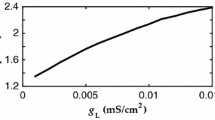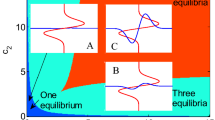Summary
Animal locomotion typically employs several distinct periodic patterns of leg movements, known as gaits. It has long been observed that most gaits possess a degree of symmetry. Our aim is to draw attention to some remarkable parallels between the generalities of coupled nonlinear oscillators and the observed symmetries of gaits, and to describe how this observation might impose constraints on the general structure of the neural circuits, i.e. central pattern generators, that control locomotion. We compare the symmetries of gaits with the symmetry-breaking oscillation patterns that should be expected in various networks of symmetrically coupled nonlinear oscillators. We discuss the possibility that transitions between gaits may be modeled as symmetry-breaking bifurcations of such oscillator networks. The emphasis is on general model-independent features of such networks, rather than on specific models. Each type of network generates a characteristic set of gait symmetries, so our results may be interpreted as an analysis of the general structure required of a central pattern generator in order to produce the types of gait observed in the natural world. The approach leads to natural hierarchies of gaits, ordered by symmetry, and to natural sequences of gait bifurcations. We briefly discuss how the ideas could be extended to hexapodal gaits.
Similar content being viewed by others
References
Alexander, J.C. (1986). Patterns at primary Hopf bifurcations of a plexus of identical oscillators.SIAM J. Appl. Math. 46, 199–221.
Alexander, R. McN. (1984). The gaits of bipedal and quadrupedal animals.Int. J. Robot. Res. 3(2), 49–59.
Alexander, R. McN. (1989). Optimization of gaits in the locomotion of vertebrates.Physiol. Rev. 69, 1199–1227.
Aristotle. De Partibus Animalium, De Incessu Animalium, De Motu Animalium. InParts of Animals, Movement of Animals, Progression of Animals (Peek, A.S., and Forster, E.S., translators). Cambridge, MA: Harvard University Press, 1936.
Ashwin, P. (1990). Symmetric chaos in systems of three and four forced oscillators.Nonlinearity 3, 603–617.
Ashwin, P., King, G.P., and Swift, J.W. (1990). Three identical oscillators with symmetric coupling.Nonlinearity 3, 585–601.
Ashwin, P. and Swift, J.W. (1992). The dynamics ofn weakly coupled identical oscillators.J. Nonlinear Sci. 2, 69–108.
Baesens, C., Guckenheimer, J., Kim, S., and MacKay, R.S. (1991). Three coupled oscillators: Mode-locking, global bifurcations, and toroidal chaos.Physica D 49, 387–475.
Bay, J.S. and Hemami, H. (1987). Modeling of a neural pattern generator with coupled nonlinear oscillators.IEEE Trans. Biomed. Eng. 34, 297–306.
Brown, T.G. (1911). The intrinsic factors in the act of progression in the mammal.Proc. Roy. Soc. B 84, 308–319.
Brown, T.G. (1914). On the nature of the fundamental activity of the nervous centres; together with an analysis of the conditioning of rhythmic activity in progression, and a theory of the evolution of function in the nervous system.J. Physiol. (Lond.) 48, 18–46.
Calabrese, R.L. (1980). Invertebrate central pattern generators: Modeling and complexity.Behav. Brain Sci. 3, 542–543.
Cohen, A.H. (1988). Evolution of the vertebrate central pattern generator for locomotion. InNeural Control of Rhythmic Movements in Vertebrates (Cohen, A.H., Rossignol, S., and Grillner, S., eds.). New York: Wiley, 129–166.
Cohen, A.H., Holmes, P.J., and Rand, R.H. (1982). The nature of the coupling between segmental oscillators of the lamprey spinal generator for locomotion: A mathematical model.J. Math. Biol. 13, 345–369.
Collins, J.J. and Stewart, I.N. (1992). Symmetry-breaking bifurcation: A possible mechansim for 2:1 frequency-locking in animal locomotion.J. Math. Biol. 30, 827–838.
Collins, J.J. and Stewart, I. (1993). Hexapodal gaits and coupled nonlinear oscillator models.Biol. Cybern 68, 287–298.
Crawford, J.D., Golubitsky, M., Gomes, M.G.M., Knoblach, E., and Stewart, I.N. (1991). Boundary conditions as symmetry constraints. InSingularities, Bifurcations, and Dynamics: Proceedings of Symposium on Singularity Theory and Its Applications, Warwick 1989 (Roberts, M.R. and Stewart, I.N., eds.), vol. 2. Lecture Notes in Mathematics Series, Springer-Verlag, Heidelberg, 63–79.
Dagg, A.I. (1973). Gaits in mammals.Mammal Rev. 3(4), 135–154.
Davis, J. (1981).Garfield: Bigger than Life. New York: Ballantine.
Delcomyn, F. (1980). Neural basis of rhythmic behavior in animals.Science 210, 492–498.
Epstein, I. and Golubitsky, M. (1992). Linear arrays of coupled cells. Preprint, University of Houston.
Ermentrout, G.B. (1986). The behavior of rings of coupled oscillators.J. Math. Biol. 23, 55–74.
Gaeta, G. (1990). Bifurcation and symmetry breaking.Phys. Reports 189, 1–87.
Gambaryan, P. (1974).How Mammals Run: Anatomical Adaptations. New York: Wiley.
Glass, L. and Young, R. E. (1979). Structure and dynamics of neural network oscillators.Brain Res. 179, 207–218.
Golubitsky, M. and Stewart, I.N. (1985). Hopf bifurcation in the presence of symmetry.Arch. Rational Mech. Anal. 87, 107–165.
Golubitsky, M. and Stewart, I.N. (1986). Hopf bifurcation with dihedral group symmetry: Coupled nonlinear oscillators. InMultiparameter Bifurcation Theory (Golubitsky, M. and Guckenheimer, J., eds.). Contemporary Math.56, Amer. Math. Soc., Providence, 131–173.
Golubitsky, M., Stewart, I.N., and Schaeffer, D.G. (1988).Singularities and Groups in Bifurcation Theory, vol. II. New York: Springer.
Grasman, J. and Jansen, M.J.W. (1979). Mutually synchronized relaxation oscillators as prototypes of oscillating systems in biology.J. Math. Biol. 7, 171–197.
Gray, J. (1968).Animal Locomotion. London: Weidenfeld and Nicolson.
Grillner, S. (1975). Locomotion in vertebrates: Central mechanisms and reflex interaction.Physiol. Rev. 55, 247–304.
Grillner, S. (1985). Neurobiological bases for rhythmic motor acts in vertebrates.Science 228, 143–149.
Grillner, S. and Wallén, P. (1985). Central pattern generators for locomotion, with special reference to vertebrates.Ann. Rev. Neurosci. 8, 233–261.
Guckenheimer, J. and Kim, S. (1990).kaos. Mathematical Sciences Institute Technical Report, Cornell University, Ithaca, New York.
Herman, R.M., Grillner, S., Stein, P.S.G., and Stuart, D.G., eds. (1976).Neural Control of Locomotion. New York: Plenum Press.
Hildebrand, H. (1965). Symmetrical gaits of horses.Science 150, 701–708.
Hildebrand, H. (1966). Analysis of the symmetrical gaits of tetrapods.Folia Biotheoretica 4, 9–22.
Hildebrand, M. (1968). Symmetircal gaits of dogs in relation to body build.J. Morphol. 124, 353–359.
von Holst, E. (1935). Erregungsbildung und Erregungsleitung im Fischrückenmark.Pflügers Arch. 235, 345–359.
von Holst, E. (1973).The Behavioral Physiology of Animals and Man. Coral Gables, FL: University of Miami Press.
Hoyt, D.F. and Taylor, R.C. (1981). Gait and the energetics of locomotion in horses.Nature 292, 239–240.
Kelso, J.A.S. and Schöner, G. (1988). Self-organization of coordinative movement patterns.Human Movement Science 7, 27–46.
Kopell, N. (1988). Toward a theory of modelling central pattern generators. InNeural Control of Rhythmic Movements in Vertebrates (Cohen, A.H., Rossignol, S., and Grillner, S., eds.). New York: Wiley, 369–413.
Kupfermann, I. and Weiss, K.R. (1978). The command neuron concept.Behav. Brain Sci. 1, 3–39.
McGhee, R.B. (1968). Some finite state aspects of legged locomotion.Math. Biosci. 2, 67–84.
McGhee, R.B. and Jain, A.K. (1972). Some properties of regularly realizable gait matrices.Math. Biosci. 13, 179–193.
Murray, J.D. (1989)Mathematical Biology. Biomathematics Texts 19. New York: Springer-Verlag.
Muybridge, E. (1899).Animals in Motion. London: Chapman and Hall. Republished Dover Publications, New York, 1957.
Muybridge, E. (1901).The Human Figure in Motion. London: Chapman and Hall. Republished Dover Publications, New York, 1955.
Raibert, M.H. (1986). Running with symmetry.Int. J. Robot. Res. 5, 3–19.
Raibert, M.H. (1988). Balance and symmetry in running. InNatural Computation (Richards, W., ed.). Cambridge, MA: MIT Press, 487–503.
Rand, R., Cohen, A.H., and Holmes, P.J. (1988). Systems of coupled oscillators as models of central pattern generators. InNeural Control of Rhythmic Movements in Vertebrates (Cohen, A.H., Rossignol, S., and Grillner, S., eds.). New York: Wiley, 333–367.
Schmidt-Nielsen, K. (1990).Animal Physiology: Adaptation and Environment. Cambridge: Cambridge University Press.
Schönder, G., Yiang, W. Y., and Kelso, J.A.S. (1990). A synergetic theory of quadrupedal gaits and gait transitions.J. Theor. Biol. 142, 359–391.
Selverston, A.I. (1980). Are central pattern generators understandable?Behav. Brain Sci. 3, 535–571.
Shik, M.L. and Orlovsky, G.N. (1976). Neurophysiology of locomotor automatism.Physiol. Rev. 56, 465–501.
Smale, S. (1974). A mathematical model of two cells via Turing's equation. InSome Mathematical Questions in Biology V (Cowan, J.D., ed.). Amer. Math. Soc. Lecture Notes on Mathematics in the Life Sciences6, Providence, 15–26.
Stein, P.S.G. (1978). Motor systems, with specific reference to the control of locomotion.Ann. Rev. Neurosci. 1, 61–81.
Swift, J.W. (1988). Hopf bifurcation with the symmetry of the square.Nonlinearity 1, 333–377.
Taft, R. (1955). An introduction: Eadweard Muybridge and his work. In Muybridge, E.The Human Figure in Motion. New York: Dover Publications, vii-xiv.
Willis, J.B. (1980). On the interaction between spinal locomotor generators in quadrupeds.Brain Res. Rev. 2, 171–204.
Yuasa, H. and Ito, M. (1990). Coordination of many oscillators and generation of locomotory patterns.Biol. Cybern. 63, 177–184.
Author information
Authors and Affiliations
Additional information
Communicated by James Murray
Rights and permissions
About this article
Cite this article
Collins, J.J., Stewart, I.N. Coupled nonlinear oscillators and the symmetries of animal gaits. J Nonlinear Sci 3, 349–392 (1993). https://doi.org/10.1007/BF02429870
Received:
Accepted:
Issue Date:
DOI: https://doi.org/10.1007/BF02429870




